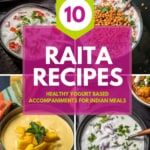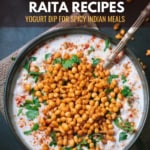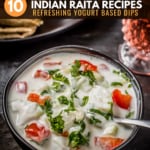Indian Raita Recipes – 10 unique and traditional variations
Note: This post contains affiliate links. As an Amazon Associate I earn from qualifying purchases.
Raitas are a perfect way to cool your palate after savoring a spicy Indian meal such as biryanis, pulaos, and parathas. Check out these 10 unique yet traditional variations of Indian yogurt raitas.
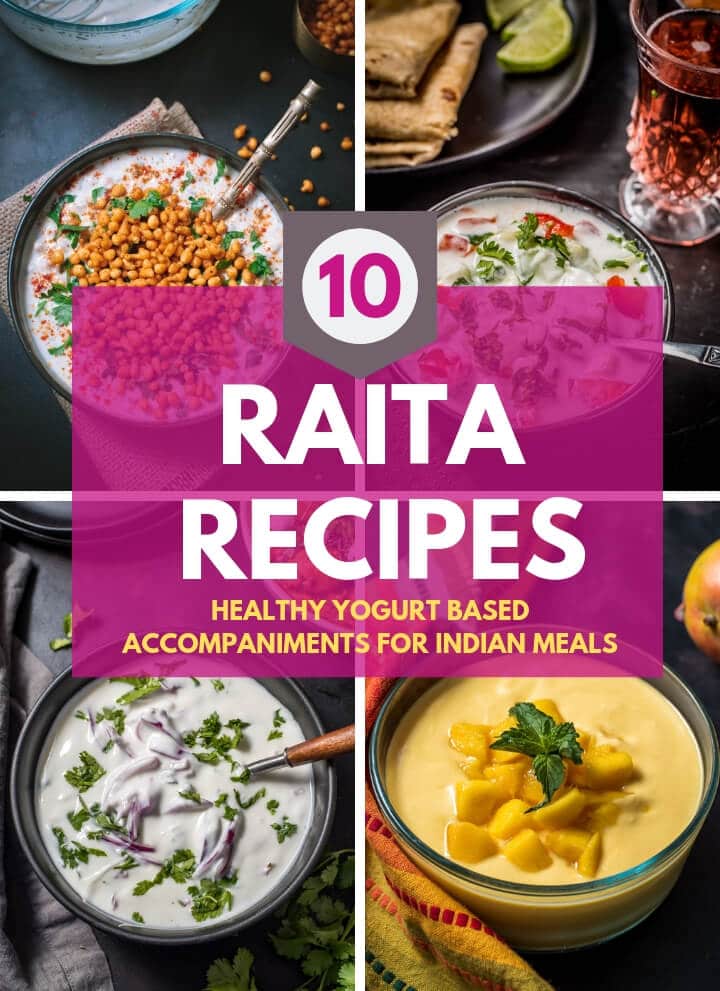
Table of contents
What is raita?
If you never had Indian raita, imagine smooth and creamy yogurt seasoned with salt, pepper, or chili powder and garnished with herbs such as finely chopped cilantro or mint.
You can have this Indian yogurt sauce as-is, or throw in some finely chopped or grated vegetables (such as cucumber, onions, tomatoes) and even fruits (pineapple, mango, etc). They make a perfect accompaniment to your favorite Indian curry or biryani recipes.
What is the difference between tzatziki and raita?
Raita sauce can also be used as a substitute for tzatziki, a dip popular in the Mediterranean and the Middle East. However, there are a few differences.
- Raita is not as thick as Tsaziki, which is made from thick yogurt.
- Tsaziki is almost always made with cucumbers, whereas with raita, you can add the veggies or fruits of your choice.
How is raita different from pachadi?
Pachadi, when broadly translated, refers to food that has been pounded almost like a chutney. A common way of making it involves combining yogurt with chopped or ground veggies or fruits with spices. It is finished by tempering it with coconut oil, mustard seeds, urad dal, and curry leaves.
Here’s how raitas and pachadis differ –
- Raita is an accompaniment that hails from North India, while pachadis are from the southern part of India.
- Raitas are almost always yogurt based, but pachadis don’t have to be. Pachadis can be yogurt-based or made by combining cooked vegetables in a coconut-based sauce, which is then tempered with mustard seeds and curry leaves.
How to make raita
While there are various versions of raita which include vegetables, fruits, and boondi (deep-fried balls made from chickpea flour ), the basic Indian raita just whisked yogurt combined with salt, finely chopped green chilies, and cilantro (or sometimes mint) as garnishing.
There is no one way to make raita, but you could say that most raitas will include at least the first 3 ingredients listed below:
Ingredients
- Thick yogurt – The best-tasting raitas use fresh, (ideally homemade) thick yogurt made from whole milk. If the yogurt is runny, make sure to strain it.
- Seasonings – You could use table salt or black salt for an extra tangy kick. Roasted cumin powder, chaat masala, and dry mango powder are often used to season raitas.
- Heat – To add a hint of heat to your raita, use either finely chopped Thai green chilies, chili powder, or freshly ground peppercorns.
- Vegetables – Cucumber (grated or chopped), onions, tomatoes, beetroot, potatoes, carrots, etc.
- Fruits – Pineapples, pomegranates, and mangoes are popular, but feel free to experiment with other fruits, such as apples and pears.
- Garnishing – finely chopped cilantro or mint leaves (fresh or dried).
- Tempering – Some raitas (like this cucumber raita) when tempered with oil, curry leaves (kadipatta) make for an exciting variation.
The ratio of yogurt to veggies and fruits can vary from one household to the other, but I prefer to keep it 1:1 like in this cucumber raita recipe.
Instructions
- Start by whisking the yogurt till it is smooth and creamy.
- If the yogurt is very thick, dilute it with a few tablespoons of either milk or yogurt.
- Add the spices and mix well.
- Fold in the chopped fruits or veggies using a spoon.
- Refrigerate for a few hours for best results.
Tips for making raita
- Raita tastes best when made with homemade yogurt. But if that’s not an option, you can use store-bought plain yogurt – just do a taste test and make sure it is not too sour.
- Instead of water you can use milk to dilute the yogurt – it also helps cut the sourness of the yogurt.
- For the best tasting raitas, use fresh produce.
How long does homemade raita last?
It tastes best if you refrigerate and consume it within a day or two.
Different types of raita recipes
Most of us have a go-to raita recipe that we rely on from time to time. But if you are someone who likes to mix things up, I have a list of 10 raita recipes for you to try.
You’ll find a few traditional recipes, some with a twist and some exciting new ones that you may have never made before. I would love for you to try them and leave me a comment on how you liked them. I can’t wait to hear from you :-).
Cucumber raita – the basic Indian raita
This basic Indian raita recipe is made from everyday pantry ingredients and can be assembled in no time. This cucumber raita is commonly made in most Indian households.
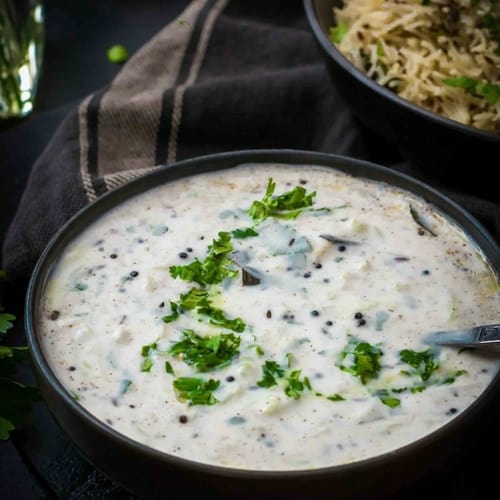
Mint raita
This refreshing spiced yogurt raita made from mint is a worthy accompaniment to delicious biryanis, parathas, and other grilled Indian foods. Learn how to make it in under 5-minutes.
Cucumber tomato raita
This delicious mix made from cucumber, chopped tomatoes, and yogurt is our favorite raita to pair with any Indian meal. In fact, this is my go-to raita for biryani recipes. Check out this recipe to find out what makes it so ‘lick-your-bowl’ good.
Pineapple raita
Eat this pineapple raita as a dessert or pair it with biryanis – this raita sauce tastes delicious either way. Also, learn my secret trick to make it irresistible.
Onion raita
You’ll probably see this popular raita served in Indian restaurants often accompanying biryanis. It is probably because it is super easy to make and only needs a few ingredients.
Boondi raita
A hot favorite in our home – my kids can’t get enough of this crunchy boondi raita made from crispy chickpea flour balls.
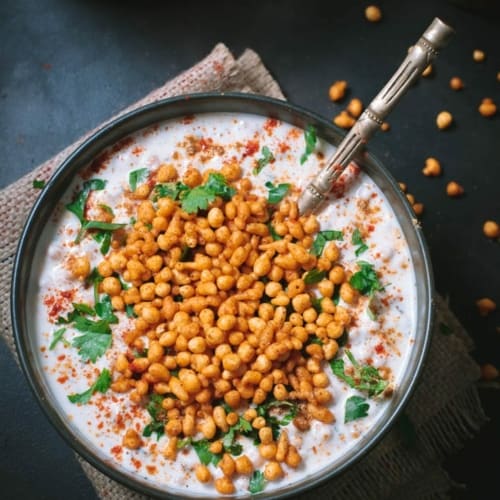
Mango raita
Anyone who loves mangoes will go ga-ga over this Mango raita recipe. Just make sure to pick mangoes that are ripe and sweet to make the best-tasting raita!
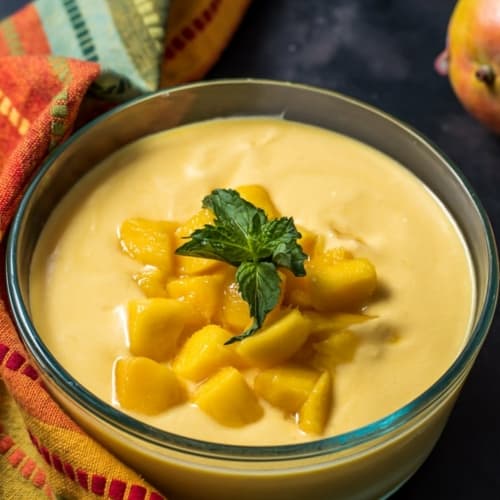
Pomegranate raita
Mint and cilantro combined with crunchy and juicy pomegranate seeds give this raita its unique twist.
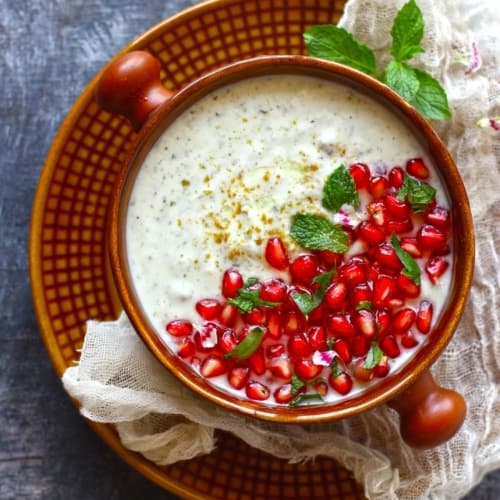
Beetroot raita
This cooling and refreshing beet raita makes a perfect side dish to pair with Indian food.
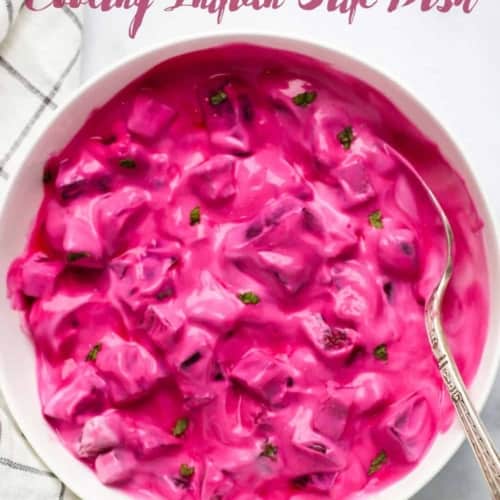
What do you eat raita with?
Raita tastes best when served cold or at room temperature.
Pair it with biryanis/pulaos, parathas, kababs, chicken tikka masala, butter chicken, or have it as-is to cool your palate down after a spicy Indian meal.

